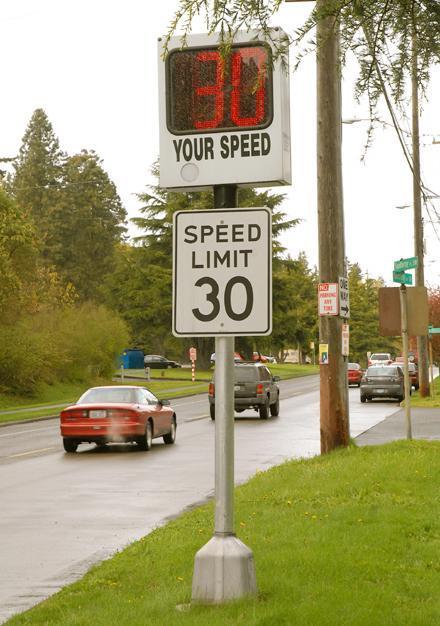City to bring us 'traffic calming'
SPEED SIGN. This speed sign gages northbound traffic and is on the east side of Fauntleroy Way, a few hundred feet north of the ferry dock.
<b>Photo by Steve Shay</b>
Tue, 04/22/2008
A few of the area's worst hotspots for speeding drivers and pedestrian safety are getting some attention from city transportation officials who said last week they plan to install "traffic calming" measures and other fixes to help slow traffic flow.
Luke Korpi, a senior civil engineer with the Seattle Department of Transportation's Neighborhood Traffic Engineering Group, said two projects would start by this summer. One will address ongoing concerns about excessive speeding on 35th Avenue Southwest in the vicinity of Southwest Juneau and Raymond.
Dubbed Interstate-35 by some High Point residents, there have been a few accidents there in the last several months and an 85-year-old man was hit killed on the street last fall. Residents of High Point are also asking for posted signs that tell drivers to look out for children playing.
Radar speed signs, digital devices that detect and display the speed of drivers, will be installed north and south bound near those intersections. The signs are a more "passive" measure, but also an "effective psychological reminder to drivers to slow down," said Korpi.
The city installs about 10 of the temporary displays throughout the city each year. This year, four will go on West Seattle streets; a pair on 35th and another two speed signs along Fauntleroy Way near the California Avenue intersection.
There is one permanent sign on Fauntleroy near Lincoln Park.
Korpi said the city is seriously looking at changing the pedestrian light at 35th and Raymond to a full traffic light.
There are also plans to install speed cushions, which were referred to as a "softer," arterial version of a speed bump, on the downhill portion of Dawson from South Seattle Community College, another high-speed area.
Both projects are funded through the city's annual Neighborhood Street Fund, a pool of money residents can apply for to make minor traffic and street improvements.
Korpi and his associate Jim Curtin, who is taking on a new role as community traffic liaison, listened to resident's concerns at a meeting last week of the West Seattle Community Safety Partnership, a group who meets monthly with the city police department about crime issues.
Curtin talked about upcoming improvements to the crosswalk at the south end of Westwood Village at 26th and Barton, which connects to the Longfellow Creek Trail. A 55-year-old woman, Therese Marie Soike, was killed crossing Barton near the shopping center in February.
Safety improvements will be done to match up the curb cuts with the crosswalk markings. Curtin said a misplaced median in the center of Barton is the cause of the problem and it will be removed. The crosswalk sign will be replaced with a brighter, florescent yellow-green sign, which are much more visible than the older yellow signs.
The goal is to get the work done by summer, said Curtin, when the city expects heavy use of the crosswalk by people walking the trail.
The West Seattle safety group is calling on the city to do something to make the Admiral Way corridor safer for drivers and pedestrians, too. The crosswalks aren't safe, and curb bulbs are needed, they say.
"Speeding and traffic congestion are the major concerns, so there is need for traffic calming to increase pedestrian safety."
Korpi said he hears a lot of concerns about speeding and that he's looking at several different traffic calming measures there.
Korpi said engineers have just recently turned their focus to addressing traffic calming on arterial streets. Arterials, typically seen as a facility to move traffic faster without obstruction, aren't set up for traditional calming measures, such as speed bumps or traffic circles, center islands at intersections typically on side streets.
There is a great need for traffic calming in Seattle neighborhoods, but the city is only able to meet a small portion of the demand. Of about 200 requests for traffic circles a year, only about 15 are installed, said Korpi.
The city chooses which areas will get traffic calming measures based on certain criteria, which include the history of collisions at a given location and the volume of traffic.
Other upcoming traffic improvements
Safe Routes to School
New school zone signage has been installed at the majority of West Seattle public and private schools. The remaining schools will receive signage in 2009.
New sidewalks will be built along Southwest Myrtle Street leading to Sanislo Elementary School. Rechannelization work at the intersection of 18th Avenue Southwest and Southwest Orchard Street will accompany the new sidewalk construction. This work is scheduled for summer of 2008.
Avalon Corridor
Pedestrian safety improvements for the Avalon Corridor are currently being studied. Major improvements at the intersections of Avalon and Genesee and Avalon and 30th Avenue Southwest/Yancy/Andover are expected in 2008 and 2009.
Admiral Corridor
The department of transportation will be evaluating various suggested pedestrian safety and traffic calming projects.
Arterial Traffic Calming
Radar speed signs are planned on the 35th Avenue Southwest corridor in the vicinity of Juneau, and on Fauntleroy Avenue Southwest in the vicinity of California. In addition, a traffic-calming project is planned for the 16th Avenue Southwest/Southwest Dawson corridor near South Seattle Community College.
These are all Neighborhood Street Fund projects scheduled for completion in 2008.
35th & Raymond
Changing the pedestrian light to a full traffic light (is among the city's highest priorities).
Beach Drive
The recommendation for "speed cushions" will be studied.
At least once or twice a week, Seattle Police Department motorcycle enforcement officers are patrolling in areas like Roxbury, Admiral Way and Highland Park Way to help calm traffic.
Source: West Seattle Community Safety Partnership and the Seattle Department of Transportation.
Rebekah Schilperoort may be reached at 783.1244 or rebekahs@robinsonnews.com


